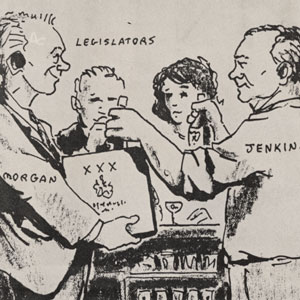On Thursday, June 29, 1967, the North Carolina General Assembly approved legislation that revolutionized higher education by creating four new universities: East Carolina University, Western Carolina University, Appalachian State University, and North Carolina A&T University. Even with beneficiaries state-wide, the legislation was first and foremost a victory for East Carolina. Its campaign for university status, launched two years prior, effectively remade higher education in North Carolina by culminating in a new set of regional universities, including East Carolina and several other institutions, two in the mountains and one traditionally African-American.
The institutional leader in this revolution in higher education was President Leo W. Jenkins at East Carolina. Working closely with ECC alumnus, chair of the ECC Board of Trustees, and state senator, Robert Morgan, Jenkins’ campaign for “a university for the East” both elevated East Carolina’s standing and effectively overturned the “one university” system privileging UNC-Chapel Hill. With East Carolina’s victory, Jenkins and his supporters expanded opportunities for students throughout the state, from the mountains to the coast, black and white. Few moments in the history of the state were as significant for its system of higher education as a whole. With East Carolina’s victory, North Carolina moved decisively from an aristocratic “one-university system” to a more democratic, multi-university system.
Jenkins’ push for university status reflected changes occurring nationwide. In the post-WWII period, state university systems underwent major changes resulting from GI Bills providing higher education opportunities for veterans. To accommodate the entry of non-traditional students, many states upgraded teachers’ colleges to colleges, and colleges to universities. At East Carolina, Jenkins had helped coordinate phenomenal growth throughout the 1950s and well into the 1960s with an influx of men, many with GI benefits, at the traditionally female campus. Faculty, buildings, programs, and the student body doubled and then tripled, making the college larger and more diverse in curricula than many existing universities. By the early 1960s, Jenkins and his supporters were simply asking that East Carolina be recognized for what it had become, a university.
The bid for university status went in tandem with Jenkins’ push to secure a medical school for East Carolina. Despite strong opposition from UNC, the N. C. Board of Higher Education, and Governor Dan K. Moore, Jenkins, a New Jersey native, persisted, often resorting to populist appeals to gain support for his mission of educational service for the people of North Carolina. With powerful allies such as state senator Robert Morgan and Lt. Governor Bob Scott, Jenkins had the necessary political clout to bypass UNC, the Board of Higher Education, and the governor with state legislation decreeing that East Carolina, as well as several other institutions, would become state-supported regional universities.
Although the new regional universities were initially denied the right to grant the Doctor of Philosophy (Ph.D.) degree, Jenkins made it clear that he would challenge that restriction on ECU’s mission of educational service. Despite being ridiculed in political cartoons statewide by newspapers opposing East Carolina’s bid, Jenkins continued his fight and within a decade achieved another victory, a four-year medical school at ECU. Along the way, the Board of Higher Education was disbanded and replaced with a new state university system governed by a Board of Governors, and headed by President William Friday, former president of UNC-Chapel Hill. Undoubtedly, however, the most momentous event in the history of higher education in the second half of the twentieth century was generated by East Carolina and its drive, led by President Leo W. Jenkins, to provide greater opportunities for all North Carolinians in higher education through the creation of a more inclusive and democratic university system.
Sources
- "Arguments on Senate Floor Concerning University Status." Series 3. Box 16, Folder 35. Records of the Board of Trustees for East Carolina University, 1907-2014. University Archives # UA01. J. Y. Joyner Library. East Carolina University. Greenville, N.C.
- "Dr. Jenkins' ECU Policy." East Carolinian. July 18, 1967. Vol. 42, no. 64. P. 1.
- "ECU Bill Passes Senate." East Carolinian. June 29, 1967. Vol. 42, no. 62. P. 1.
- "ECC Finally Gains Victory." Statesville Record and Landmark. June 29, 1967. P. 1.
- Falk, Lawrence. "Raleigh Observers Give ECU Fair Chance." The Daily Independent (Kannapolis). June 5, 1967. P. 3.
- Hensley, Jay. "Assembly Enacts Universities Bill." Asheville Citizen-Times. June 30, 1967.
- "Here Stands A University." East Carolinian. September 12, 1967. Vol. 43, no. 1. P. 1.
- Jenkins, Leo W. A Regional University: Another Need for the East, A Speech. Greenville: East Carolina College, 1966.
- Leo W. Jenkins oral history interview, May 24, 1978. Identifier: OH0051. J. Y. Joyner Library. East Carolina University. Greenville, N.C. https://digital.lib.ecu.edu/3737
- "Regional U's on the brink." The Daily Tar Heel. June 27, 1967. P. 4.
- Robert Morgan Papers (#268), East Carolina Manuscript Collection, J. Y. Joyner Library, East Carolina University, Greenville, North Carolina, USA.
- Shires, William A. "ECC Issue Explodes into Power Struggle." Asheville Citizen-Times. April 2, 1967. P. 2.
- Shires, William A. "Present Assembly To Be Remembered For Passing Regional University Plan." Rocky Mount Telegram. July 3, 1967. P. 6.
- "State Now Boasts Four Universities." The Daily Independent. June 30, 1967. P. 1.
- "University Status." Series 12. Box 40, Folders 10. Records of Leo Warren Jenkins' Tenure as President and Chancellor, 1960-1978. University Archives # UA02-06. J. Y. Joyner Library. East Carolina University. Greenville, N.C.
Citation Information
Title: University Status
Author: John A. Tucker, PhD
Date of Publication: 7/18/2019
